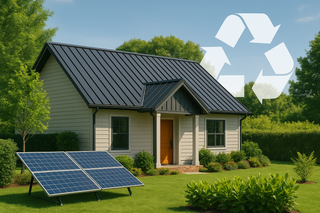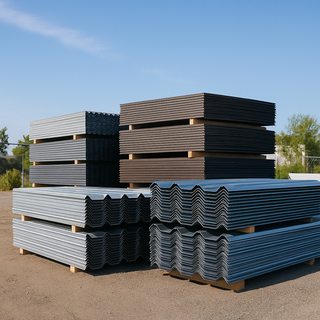As sustainability becomes a priority for homeowners, builders, and municipalities, one of the most impactful decisions you can make lies just above your head — your roof.
While many roofing materials claim to be environmentally friendly, metal roofing stands out as one of the most genuinely eco-conscious choices available. From its recycled content to its reflectivity, durability, and 100% recyclability, metal roofing delivers long-term environmental benefits at every stage of its life cycle.
At Top Tier Metals, we believe that sustainable building should be smart, accessible, and beautiful. In this extensive guide, we’ll walk you through how metal roofing aligns with eco-friendly construction — from cradle to cradle.
1. What Makes Metal Roofing an Eco-Friendly Option?
Most roofing systems take a toll on the environment due to:
-
Frequent replacement cycles
-
Limited recyclability
-
Toxic production processes
-
Poor thermal performance
Metal roofing flips the script, offering:
-
High recycled content
-
Exceptional longevity (40–70 years)
-
Cool roof coatings for energy savings
-
100% recyclability at the end of life
-
Minimal maintenance over decades
It’s one of the only roofing materials that improves sustainability at every stage — from manufacture to teardown.
2. Recycled Content: Starting With Sustainable Inputs
Metal roofing panels — especially steel and aluminum — often contain 25% to 95% recycled content at the time of manufacturing.
Key Materials:
-
Galvalume steel: Typically contains 30%+ recycled content
-
Aluminum panels: Often over 90% recycled (mostly from beverage cans and scrap)
Recycling these metals consumes 95% less energy than producing new materials from raw ore. That means your roof starts its life with a dramatically lower carbon footprint than asphalt or tile.
3. Durability = Reduced Waste
Every time a roof is replaced, the old one usually ends up in a landfill.
Asphalt shingles:
-
Last 15–25 years
-
Often non-recyclable due to adhesives and fiberglass mesh
-
11 million tons of shingle waste are generated every year in the U.S.
Metal roofs:
-
Last 40–70 years or more with minimal degradation
-
Can be repainted or re-coated instead of replaced
-
Withstands harsh climates, hail, high winds, and snow loads
Fewer replacements = fewer trucks, fewer landfills, and less pollution.
4. End-of-Life Recycling: 100% Reclaimable
When a metal roof reaches the end of its useful life — usually after decades of protection — it doesn’t go to waste.
Instead, it’s fully recyclable and can be melted down for reuse in:
-
New roofing panels
-
Auto parts
-
Appliances
-
Beams and framing
-
Cans and containers
There is zero degradation in quality during recycling, which means it can be repurposed indefinitely.
Compare that to asphalt, clay, or wood shakes, which typically end up as unrecyclable waste.
5. Energy Efficiency & Cool Roofing Benefits
Metal roofs are highly reflective, making them one of the best materials for reducing summer heat gain.
With cool roof coatings:
-
Reflect up to 70% of solar energy
-
Reduce indoor temps by 10–15°F
-
Lower cooling costs by up to 25%
These coatings reduce urban heat island effect, decrease peak energy loads, and make homes more comfortable — especially in hot and sunny climates.
And since metal doesn't absorb water, snow and ice slide off easily, reducing winter heating costs as well.
6. Lightweight + Efficient Shipping = Lower Emissions
Metal panels are lighter than tile or slate, reducing the energy required for:
-
Transport from mill to warehouse
-
Shipment to your jobsite
-
Structural reinforcements at install
This reduced shipping weight also decreases emissions from logistics compared to other premium roofing systems.
Plus, custom-cut panels like the ones from Top Tier Metals mean fewer offcuts and waste on-site — another win for sustainability.
7. Low Maintenance = Lower Resource Consumption
Eco-consciousness isn’t just about production — it’s also about long-term impact.
Metal roofing:
-
Requires no toxic treatments or sealants
-
Doesn’t degrade from UV or algae
-
Rarely needs to be patched or recoated
-
Reduces the need for repeated site visits, repairs, and labor
That means fewer chemical cleaners, less water use, and minimal mechanical disruption over decades of service.
8. LEED, Green Building, and Tax Credit Eligibility
Metal roofing contributes to a variety of green building certifications and incentives:
-
LEED Points: For recycled content, cool roof ratings, and recyclability
-
Energy Star compliance: Most metal roofs meet or exceed reflective standards
-
Federal and local tax credits: In some areas, cool metal roofs qualify for energy efficiency rebates
Ask our team at Top Tier Metals if your system qualifies — we’re happy to help you get every benefit you deserve.
9. Aesthetic Sustainability: Timeless Design Reduces Renovation
Design matters. A well-chosen metal roof can blend with changing styles over decades, helping you avoid “outdated” roof replacements purely for aesthetics.
Choose timeless profiles like:
-
Standing seam
-
Corrugated
-
Matte charcoal or Galvalume finishes
These styles look just as good in 2040 as they do today — and they pair with almost every siding and window trim color. Sustainable and stylish.
10. Eco-Roof Myths: What You Might Hear (That Isn’t True)
Let’s clear up some common misconceptions:
MYTH: Metal roofs are energy intensive to make
FACT: Recycled metal uses 95% less energy than virgin metal, and most panels contain high recycled content.
MYTH: They’re loud when it rains
FACT: Proper underlayment and insulation make them quieter than asphalt in most homes.
MYTH: They don’t work with solar panels
FACT: Standing seam metal roofs are ideal for solar — you can mount without drilling holes.
MYTH: They rust easily
FACT: With Galvalume or PVDF coatings, modern metal roofs are nearly rust-proof for 40+ years.
Final Thoughts: A Roof That’s Built for Tomorrow
If you're serious about sustainability, your roof should reflect your values — literally and figuratively.
Metal roofing isn’t just “greenwashing.” It’s a proven, performance-based solution that reduces energy bills, eliminates replacement waste, and closes the recycling loop.
At Top Tier Metals, we help homeowners and DIYers get the highest-quality materials that don’t just last — they matter.
Ready to Build an Eco-Conscious Roof?
Contact our team to discuss environmentally friendly materials, color options, and cost-effective panel choices for your project.
👉 Contact Our Team | 📞 Call Now






